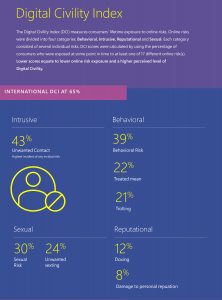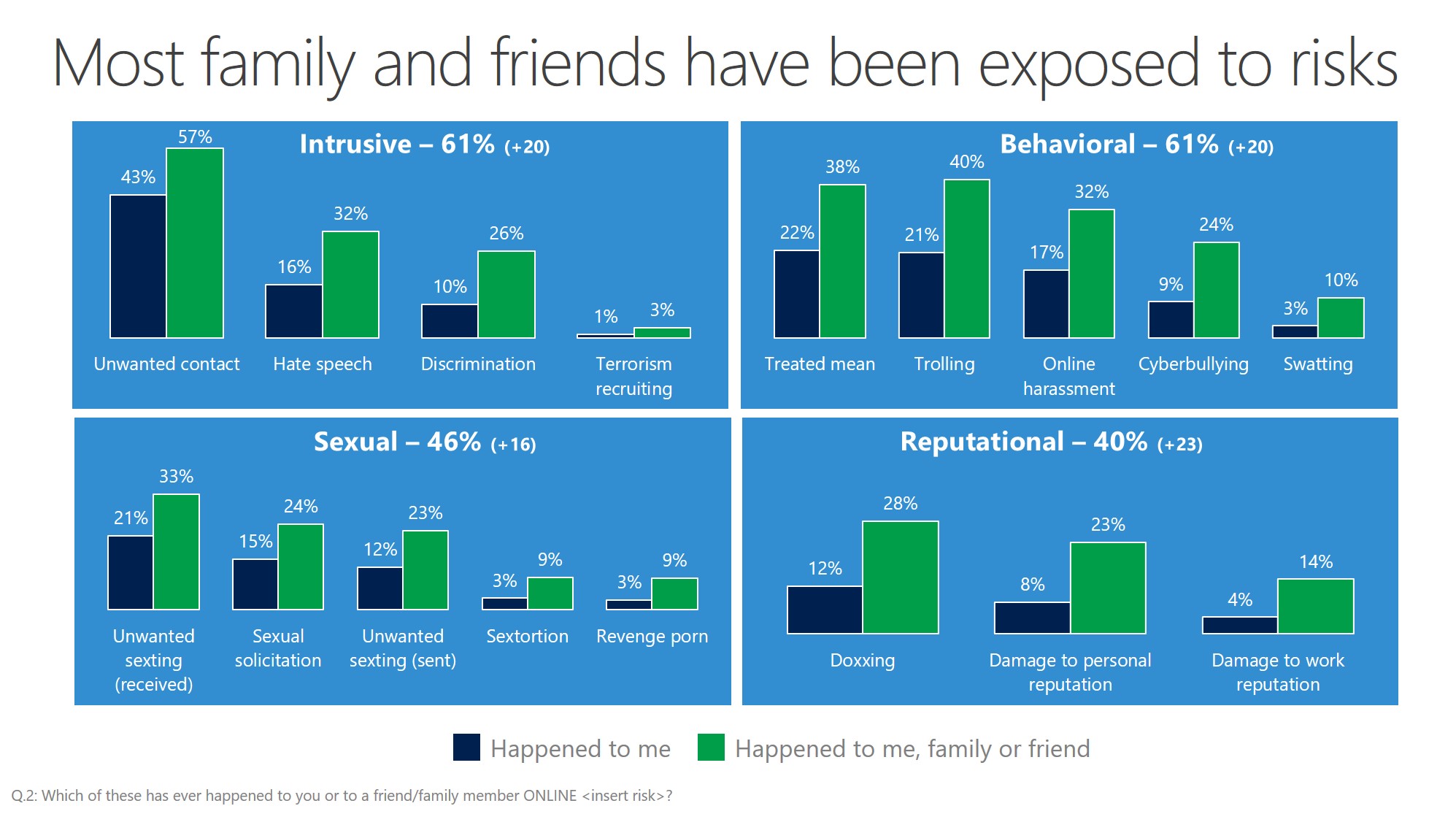It’s Safer Internet Day 2017, and Microsoft is challenging people around the world to embrace “digital civility” and to treat each other with respect and dignity online. It may sound simple, but new Microsoft research shows people are concerned about the tone of online interactions and worry that risks will increase in the future.
The research prompted the creation of our Digital Civility Index, which we’re also announcing today – a new measure of people’s safety online and exposure to risks.

New global study on civility, safety and online interactions
Last June, we conducted a study in 14 countries,[1] gauging the attitudes and perceptions of teens (ages 13-17) and adults (ages 18-74) about the state of digital civility today. We measured survey respondents’ lifetime exposure to 17 online risks[2] across four categories: behavioral, reputational, sexual and personal/intrusive.
Some of the questions we asked included:
- How do you feel about civility, safety and interactions online?
- Which online risks have you and your close circle experienced?
- How concerned are you about those 17 risks?
- When and how often have the risks occurred?
- What consequences and actions were taken?
- Where did you and others turn for help?
Results show people experienced these top five risks online:
- Unwanted contact
- Being treated mean
- Trolling
- Receiving unwanted sexts
- Online harassment
Here are some additional highlights from our research:
- Two out of three respondents said they had fallen victim to at least one risk; that percentage swelled to 78 percent when participants also accounted for the online experiences of their friends and family members.
- 50 percent reported being “extremely or very” worried about life online generally.
- 62 percent said they did not know or were unsure where to get help when they encountered an online risk.
Benchmarking the state of digital civility
We used the results to inform what we’re calling our “Digital Civility Index.” We computed the index for each country surveyed, as well as an international reading that includes all 14. The index works like a golf score: the lower the value (on a scale from zero to 100), the lower the respondents’ risk exposure and the higher the perceived level of online civility among people in that country.
The international Digital Civility Index score stands at 65. Results show a person, on average, experienced 2.2 online safety risks out of the 17 included in the study. Countries that registered the lowest index readings (and thus the highest levels of perceived digital civility) were the U.K. (45) Australia (51), and the U.S. (55). Countries on the lower end were South Africa (78), Mexico (76) and Russia (74). The new index builds on the Microsoft Computing Safety Index released from 2010 to 2013, specifically that index’s behavioral component.
So, what does all this mean? People are establishing social norms online that include treating each other with respect and dignity, but there’s more that we can all do. We’d like to see digital civility – grounded in empathy – become a universal message and a common-sense behavior, so the internet can be a safe place for everyone to exchange ideas, learn, play and connect.
Join our Digital Civility Challenge
In an attempt to put empathy more front and center in digital dialogues, we’re introducing Microsoft’s Digital Civility Challenge. The challenge calls on people to commit daily to four ideals and to share their pledge on social media, using the hashtags #Challenge4Civility and #Im4DigitalCivility. Specifically, we’re encouraging individuals to:
- Live the Golden Rule by acting with empathy, compassion and kindness in every interaction, and treating everyone they connect with online with dignity and respect.
- Respect differences and honor diverse perspectives, and when disagreements surface to engage thoughtfully, and avoid name-calling and personal attacks.
- Pause before replying to things people disagree with, and not posting or sending anything that could hurt someone else, damage reputations or threaten people’s safety.
- Stand up for myself and others by supporting those who are targets of online abuse or cruelty, reporting activity that threatens anyone’s safety, and preserving evidence of inappropriate or unsafe behavior.
As we rally people, peers and partners to join our challenge, we recognize and will continue to seek opportunities to unite our work with others’. For example, the Tyler Clementi Foundation’s #endbullying campaign highlights that people behave behind keyboards in ways they would never conduct themselves face to face – largely because empathy isn’t naturally present in the digital space.
“We could eradicate most cruelty, bullying and humiliation that occurs online if every bystander became an ‘upstander,’” says Sean Kosofsky, executive director of the Tyler Clementi Foundation. “We can interrupt harassment, report it and reach out to the affected person.” (Click here for additional comments from other leading advocacy organizations and groups in favor of spreading the word about digital civility.)
Best practices for digital civility
Beyond informative data and fun social challenges, we need to unite and grow a culture of digital civility – and everyone has a role to play. Microsoft’s aim with this new initiative is to start a conversation about how being civil online can benefit society. Indeed, civility in everyday interactions fosters vibrant, engaged communities.
Along with the new index, we’re also sharing suggested best practices for digital civility. As I recently said, we don’t profess to have all the answers – not by any means, but we want to offer an evidentiary starting point for further discussion and engagement. Our hope is that policymakers, companies and organizations will consider our suggestions and build on our initial efforts through fresh digital civility-related projects and programs.
Safer Internet Day resources
We hope you’ll get involved this Safer Internet Day, and champion digital civility today and throughout the year. Our website and resources page are a great place to start. They offer advice and guidance for exploring and handling almost any online safety situation. Additionally, beginning today, Microsoft Store locations across the United States will offer free Online Safety workshops available for anyone. Whether you’re a student looking for ways ensure your privacy or a parent who wants to learn the best practices for keeping your family safe online, you can learn more by visiting your local Microsoft Store and signing up for a free, in-store Online Safety workshop.
For more regular news and information, connect with us on Facebook and Twitter. Take the Digital Civility Challenge today and let’s aim to make Safer Internet Day 2017 the most thoughtful and fruitful yet!
––
[1] Countries surveyed: Australia, Belgium, Brazil, Chile, China, France, Germany, India, Mexico, Russia, South Africa, Turkey, the United Kingdom and the United States.
[2] Risks discussed:
- Behavioral – Treated mean, trolling, online harassment, cyberbullying, swatting
- Reputation – Doxing, damage to personal reputation, damage to work reputation
- Sexual – Receiving unwanted sexts, solicitation, sending unwanted sexts, sextortion, “revenge porn”
- Personal/Intrusive – Unwanted contact, hate speech, discrimination, terrorism recruiting
At the time of writing of this post, Jacqueline Beauchere’s title was Chief Online Safety Officer.


